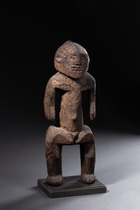Power figure "njom" · Cameroon, Keaka · ID: 3051884
Description
wood, heavily encrusted patina, base
These schematized figures with their typical thick soot patina have been causing confusion for a long time. Should they be attributed to the Keaka, as Hans-Joachim Koloss, Barry Hecht and Jill Salmons did? For many years this was considered wrong and the figures were categorized as Kaka.
Bruno Claessens recently explored this confusing topic in detail and returned to the beginnings. In his catalogue for the exhibition “Révélée - Unveiled” at the Parcour des Mondes, Paris, 10-15 September 2024, he explores the history, origins and stylistic characteristics of Keaka sculptures. His meticulous academic research redefines the Keaka’s unique contribution to African art and emphasises the exceptional character of their statues.
Jill Salmons (and other authors after her) assumed that all Keaka figures could be regarded as “enok-ateng” statues, as once described by Hans-Joachim Koloss. Koloss reported that local Keaka healers used “medicin”’ or “power” figures called “enok ateng”’, which means “fighting alone”. These figures were said to have been created to aid the healing process by helping to ward off evil forces. The figures were used in a ritual in which herbs and sacrificial blood were applied to the body while the healer implored the gods to grant the sculpture power.
Claessens recognises the research findings of Koloss. However, he sees the anthropomorphic “enok ateng” statues as part of a broader category of ritual objects known as “ajom” (sing. “njom”) - “magic medicine”. “Ajom” played an important role in the struggle for life among the Keaka, in times when an individuals life expectancy was short while constantly being surrounded by many types of dangers.
What is certain is that the figures remain fascinating and shrouded in mystery. The abstract interpretation of the human body lends these statues a modern, universal appeal, while their typical, thickly encrusted patina surrounds them with something mysterious and mystical.
Comparing literature
Duende Art Projects, Bruno Cleassens: "Révélée - Unveiled", Parcour des Mondes, Paris, 2024




